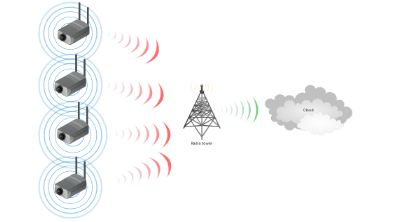Trust Management for the LPWAN Devices in a Smart City
Keywords:
Smart cities, Sustainable development, Infrastructure, Energy efficiency, Security, Urban PlanningAbstract
The Internet of Things (IoT) is used in several domains like health care, transportation, military, banking, and many more. These applications can lead to the realization of a smart city application. Recently, Low Power Wide Area Networks (LPWAN) have been getting attention to implement various IoT applications. However, LPWAN devices are deployed in an environment where they can face malicious cyber-attacks leading to compromised data. To make successful network communication, security is an important factor that must be taken into consideration. Previously, many solutions involving sophisticated data encryption and machine learning techniques have been proposed for this purpose. However, they require processing power which is mostly not available in the LPWAN devices. Here, we can apply lightweight trust management techniques to find the reliability of a node. In this article, we propose a trust management framework for securing LPWAN-based Smart City applications. Multiple Smart City case studies are considered for evaluating the proposed technique and results show better intruder detection.References
M. Angelidou, “Smart city policies: A spatial approach,” Cities, vol. 41, pp. S3–S11, Jul. 2014, doi: 10.1016/J.CITIES.2014.06.007.
P. Neirotti, A. De Marco, A. C. Cagliano, G. Mangano, and F. Scorrano, “Current trends in Smart City initiatives: Some stylised facts,” Cities, vol. 38, pp. 25–36, Jun. 2014, doi: 10.1016/J.CITIES.2013.12.010.
D. Belanche, L. V. Casaló, and C. Orús, “City attachment and use of urban services: Benefits for smart cities,” Cities, vol. 50, pp. 75–81, Feb. 2016, doi: 10.1016/J.CITIES.2015.08.016.
A. Caragliu, C. del Bo, and P. Nijkamp, “Smart cities in Europe,” J. Urban Technol., vol. 18, no. 2, pp. 65–82, Apr. 2011, doi: 10.1080/10630732.2011.601117.
M. P. Robertas Jucevičius, Irena Patašienė, “Digital Dimension of Smart City: Critical Analysis,” Procedia - Soc. Behav. Sci., vol. 156, no. 26, pp. 146–150, 2014, doi: https://doi.org/10.1016/j.sbspro.2014.11.137.
P.P. Ray, “A survey on Internet of Things architectures,” J. King Saud Univ. - Comput. Inf. Sci., vol. 30, no. 3, pp. 291–319, 2018, doi: https://doi.org/10.1016/j.jksuci.2016.10.003.
U. Raza, P. Kulkarni, and M. Sooriyabandara, “Low Power Wide Area Networks: An Overview,” IEEE Commun. Surv. Tutorials, vol. 19, no. 2, pp. 855–873, Apr. 2017, doi: 10.1109/COMST.2017.2652320.
N. K. S. Aggarwal, “Attacks on Blockchain Working model,” Adv. Comput. Elsevier, vol. 121, 2021.
J. Bennaceur, H. Idoudi, and L. Azouz Saidane, “Trust management in cognitive radio networks: A survey,” Int. J. Netw. Manag., vol. 28, no. 1, Jan. 2018, doi: 10.1002/NEM.1999.
“Leader in Cybersecurity Protection & Software for the Modern Enterprises - Palo Alto Networks.” Accessed: Feb. 25, 2025. [Online]. Available: https://www.paloaltonetworks.com/
“(PDF) A Study on Black Hole Attack in Wireless Sensor Networks.” Accessed: Feb. 25, 2025. [Online]. Available: https://www.researchgate.net/publication/317339617_A_Study_on_Black_Hole_Attack_in_Wireless_Sensor_Networks
“(PDF) Routing Attacks in Wireless Sensor Networks: A Survey.” Accessed: Feb. 25, 2025. [Online]. Available: https://www.researchgate.net/publication/263967791_Routing_Attacks_in_Wireless_Sensor_Networks_A_Survey
Z. Banković, J. C. Vallejo, D. Fraga, and J. M. Moya, “Detecting Bad-Mouthing Attacks on Reputation Systems Using Self-Organizing Maps,” Lect. Notes Comput. Sci. (including Subser. Lect. Notes Artif. Intell. Lect. Notes Bioinformatics), vol. 6694 LNCS, pp. 9–16, 2011, doi: 10.1007/978-3-642-21323-6_2.
P. N. C. AMOL R. DHAKNE, “DETECTION OF ON-OFF ATTACK BASED ON PREDECTABILITY TRUST IN WIRELESS SENSOR NETWORK,” Int. J. Adv. Comput. Eng. Netw., vol. 4, no. 12, 2016, [Online]. Available: https://www.iraj.in/journal/journal_file/journal_pdf/3-325-148463785729-33.pdf
“Ekran - Wikipedia.” Accessed: Feb. 25, 2025. [Online]. Available: https://en.wikipedia.org/wiki/Ekran
L. K. Bysani and A. K. Turuk, “A survey on selective forwarding attack in wireless sensor networks,” 2011 Int. Conf. Devices Commun. ICDeCom 2011 - Proc., 2011, doi: 10.1109/ICDECOM.2011.5738547.
“(PDF) A Survey on Detection of Sinkhole Attack in Wireless Sensor Network.” Accessed: Feb. 25, 2025. [Online]. Available: https://www.researchgate.net/publication/282024860_A_Survey_on_Detection_of_Sinkhole_Attack_in_Wireless_Sensor_Network
S. Qazi, R. Raad, Y. Mu, and W. Susilo, “Securing DSR against wormhole attacks in multirate ad hoc networks,” J. Netw. Comput. Appl., vol. 36, no. 2, pp. 582–592, Mar. 2013, doi: 10.1016/J.JNCA.2012.12.019.
Rupali Sharma, “Gray-hole Attack in Mobile Ad-hoc Networks : A Survey,” Rupali Sharma / Int. J. Comput. Sci. Inf. Technol., vol. 7, no. 3, pp. 1457–1460, 2016, [Online]. Available: https://www.ijcsit.com/docs/Volume 7/vol7issue3/ijcsit2016070389.pdf
“Investopedia.” Accessed: Feb. 25, 2025. [Online]. Available: https://www.investopedia.com/
“OWASP - Wikipedia.” Accessed: Feb. 25, 2025. [Online]. Available: https://en.wikipedia.org/wiki/OWASP
Z. A. Khan and P. Herrmann, “A trust based distributed intrusion detection mechanism for internet of things,” Proc. - Int. Conf. Adv. Inf. Netw. Appl. AINA, pp. 1169–1176, May 2017, doi: 10.1109/AINA.2017.161.
J. Gao, W. Xu, S. Kanhere, S. Jha, and W. Hu, “Poster abstract: A novel modeling involved security approach for lora key generation,” Proc. - 2020 19th ACM/IEEE Int. Conf. Inf. Process. Sens. Networks, IPSN 2020, pp. 327–328, Apr. 2020, doi: 10.1109/IPSN48710.2020.00-23.
S. L. K. I. Ahmad, K. -L. A. Yau, M. H. Ling, “Trust and Reputation Management for Securing Collaboration in 5G Access Networks: The Road Ahead,” IEEE Access, vol. 8, pp. 62542–62560, 2020, doi: 10.1109/ACCESS.2020.2984318.
V. Ribeiro, R. H. Filho, and A. Ramos, “A Secure and Fault-Tolerant Architecture for LoRaWAN Based on Blockchain,” 2019 3rd Cyber Secur. Netw. Conf. CSNet 2019, pp. 35–41, Oct. 2019, doi: 10.1109/CSNET47905.2019.9108933.
S. U. J. K. A. Awan, I. U. Din, M. Zareei, M. Talha, M. Guizani, “HoliTrust-A Holistic Cross-Domain Trust Management Mechanism for Service-Centric Internet of Things,” IEEE Access, vol. 7, pp. 52191–52201, 2019, doi: 10.1109/ACCESS.2019.2912469.
S. U. J. K. A. Awan, I. Ud Din, A. Almogren, M. Guizani, A. Altameem, “RobustTrust – A Pro-Privacy Robust Distributed Trust Management Mechanism for Internet of Things,” IEEE Access, vol. 7, pp. 62095–62106, 2019, doi: 10.1109/ACCESS.2019.2916340.
K. Harsanyi, A. Kiss, and T. Sziranyi, “Wormhole detection in wireless sensor networks using spanning trees,” 2018 IEEE Int. Conf. Futur. IoT Technol. Futur. IoT 2018, vol. 2018-January, pp. 1–6, Mar. 2018, doi: 10.1109/FIOT.2018.8325596.
X. S. ye Zhengwang, Tao Wen, Zhenyu Liu, “An Efficient Dynamic Trust Evaluation Model for Wireless Sensor Networks,” J. Sensors, vol. 2, pp. 1–16, 2017, doi: 10.1155/2017/7864671.
N. Alsaedi, F. Hashim, A. Sali, and F. Z. Rokhani, “Detecting sybil attacks in clustered wireless sensor networks based on energy trust system (ETS),” Comput. Commun., vol. 110, pp. 75–82, Sep. 2017, doi: 10.1016/J.COMCOM.2017.05.006.
J. H. P. D. -Y. Kim, S. Kim, “Remote Software Update in Trusted Connection of Long Range IoT Networking Integrated With Mobile Edge Cloud,” IEEE Access, vol. 6, pp. 66831–66840, 2018, doi: 10.1109/ACCESS.2017.2774239.
M. K. H. Hellaoui, A. Bouabdallah, “TAS-IoT: Trust-Based Adaptive Security in the IoT,” 2016 IEEE 41st Conf. Local Comput. Networks (LCN), Dubai, United Arab Emirates, pp. 599–602, 2016, doi: 10.1109/LCN.2016.101.
E. K. Wang, T. Y. Wu, C. M. Chen, Y. Ye, Z. Zhang, and F. Zou, “MDPAS: Markov Decision Process based adaptive security for sensors in Internet of things,” Adv. Intell. Syst. Comput., vol. 329, pp. 389–397, 2015, doi: 10.1007/978-3-319-12286-1_40.
I. R. Chen, J. Guo, and F. Bao, “Trust Management for SOA-Based IoT and Its Application to Service Composition,” IEEE Trans. Serv. Comput., vol. 9, no. 3, pp. 482–495, May 2016, doi: 10.1109/TSC.2014.2365797.
S. A. Muhammad Fayaz, Ajab Khan, Gulzar Mehmood, “Counteracting Selfish Nodes Using Reputation Based System in Mobile Ad Hoc Networks,” Electronics, 2022, doi: 10.3390/electronics11020185.
P. Herrmann, “Temporal logic-based specification and verification of trust models,” Lect. Notes Comput. Sci. (including Subser. Lect. Notes Artif. Intell. Lect. Notes Bioinformatics), vol. 3986 LNCS, pp. 105–119, 2006, doi: 10.1007/11755593_9.

Downloads
Published
How to Cite
Issue
Section
License
Copyright (c) 2025 50SEA

This work is licensed under a Creative Commons Attribution 4.0 International License.




















